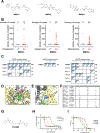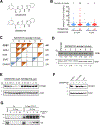Inducible mismatch repair streamlines forward genetic approaches to target identification of cytotoxic small molecules
- PMID: 37607550
- PMCID: PMC10841267
- DOI: 10.1016/j.chembiol.2023.07.017
Inducible mismatch repair streamlines forward genetic approaches to target identification of cytotoxic small molecules
Abstract
Orphan cytotoxins are small molecules for which the mechanism of action (MoA) is either unknown or ambiguous. Unveiling the mechanism of these compounds may lead to useful tools for biological investigation and new therapeutic leads. In selected cases, the DNA mismatch repair-deficient colorectal cancer cell line, HCT116, has been used as a tool in forward genetic screens to identify compound-resistant mutations, which have ultimately led to target identification. To expand the utility of this approach, we engineered cancer cell lines with inducible mismatch repair deficits, thus providing temporal control over mutagenesis. By screening for compound resistance phenotypes in cells with low or high rates of mutagenesis, we increased both the specificity and sensitivity of identifying resistance mutations. Using this inducible mutagenesis system, we implicate targets for multiple orphan cytotoxins, including a natural product and compounds emerging from a high-throughput screen, thus providing a robust tool for future MoA studies.
Keywords: Forward Genetics; High throughput screens; Mechanism of Action; Molecular Glue; Target Identification; Targeted protein degradation.
Copyright © 2023 Elsevier Ltd. All rights reserved.
Conflict of interest statement
Declaration of interests C.J.B.H. and B.T.N. are employees and own equity in Hexagon Bio. D.N. is a consultant and owns equity in Hexagon Bio.
Figures







Update of
-
Inducible mismatch repair streamlines forward genetic approaches to target identification of cytotoxic small molecules.bioRxiv [Preprint]. 2023 Feb 21:2023.02.21.529401. doi: 10.1101/2023.02.21.529401. bioRxiv. 2023. Update in: Cell Chem Biol. 2023 Nov 16;30(11):1453-1467.e8. doi: 10.1016/j.chembiol.2023.07.017. PMID: 36865268 Free PMC article. Updated. Preprint.
Comment in
-
Fine-tuning chemical genetics to identify physiologic drug targets.Cell Chem Biol. 2023 Nov 16;30(11):1331-1333. doi: 10.1016/j.chembiol.2023.10.017. Cell Chem Biol. 2023. PMID: 37977127
References
Publication types
MeSH terms
Substances
Grants and funding
LinkOut - more resources
Full Text Sources

